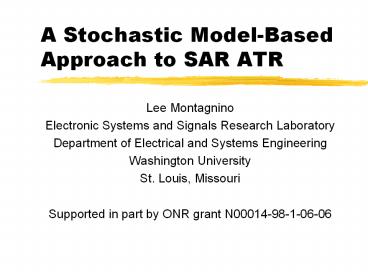A Stochastic Model-Based Approach to SAR ATR PowerPoint PPT Presentation
Title: A Stochastic Model-Based Approach to SAR ATR
1
A Stochastic Model-Based Approach to SAR ATR
- Lee Montagnino
- Electronic Systems and Signals Research
Laboratory - Department of Electrical and Systems Engineering
- Washington University
- St. Louis, Missouri
- Supported in part by ONR grant N00014-98-1-06-06
2
Presentation Overview
- Problem Definition
- Likelihood Approach to ATR
- Conditionally Gamma Model
- Conditionally K distribution
- Azimuth Correlation Model
- Conclusions
3
Problem Definition
- Typical Recognition Scenario
Imaging Platform
Target Classifier
Orientation Estimator
4
Problem Definition
- Model-Based Recognition
Target Classifier
Orientation Estimator
5
Problem Definition
- Model-Based Recognition
Training Data
Functional Estimation
Scene and Sensor Physics
Image
Processing
Inference
6
Problem Definition
- Use Modular Software Test Bed to Perform
- Direct comparisons of different stochastic models
- Performance analysis under a wide range of
testing and training scenarios - Detailed study of performance vs. models and
model parameters
7
Likelihood Approach to ATR
- Target Class and Pose Estimates
8
Likelihood Approach to ATR
- Generalized Likelihood Ratio Test and
Maximum-A-Posteriori Estimation
9
MSTAR DATA SET
- A collection of spotlight mode SAR images from a
number of target classes - Using 4 target classes from the public release
set - Using 10 target classes from the public release
set - MSTAR Program sponsored by DARPA and Wright
Laboratory
10
MSTAR Data Set
- Partitioned into two subsets
- 17 depression images used for estimating
likelihood functions - 15 depression images used for experimentally
assessing performance - For testing, we assume a uniform prior on
orientation and target class
11
Gamma Distribution
- Multi-parameter distribution
- Relaxation of the quarter-power normal model
- Relates to Work in MSTAR Program at WPAFB
12
Gamma Estimates
- Maximum Likelihood Estimates
- where
13
Gamma Results
- Percentage of Correct Classification and
Orientation Estimation Error
14
K Distribution
- Multi-Parameter
- Mixture model
- Models Specular and Diffuse Reflectivity
15
K Estimates
- Expectation-Maximization
16
K Results
- Percentage of Correct Classification and
Orientation Estimation Error
17
Azimuth Correlation
- Radar data correlated in azimuth
18
Azimuth Correlation Functions
- EM Algorithm to Find Estimates of
19
Azimuth Correlation Covariance Images
20
Azimuth Correlation Results
- Percentage of Correct Classification and
Orientation Estimation Error
21
Conclusions
- Gamma Distribution Model
- low recognition rates
- poor orientation estimation
- K distribution model
- comparable recognition rates to the zero-mean
conditionally Gaussian presented by DeVore
22
Conclusion
- Azimuth Correlation
- comparable recognition rates to the zero-mean
conditionally Gaussian model presented by DeVore - best orientation estimation error rates of any
distribution - correlation models dont match actual data
23
Questions
24
References
25
References

